The development economists and policy makers are unanimous in their view that the development of social sector is most crucial for accelerated economic development with adequate emphasis on social justice. However, only increase in social sector expenditure will not be adequate. Policy makers should also focus on efficient allocation of resources to target the actual deprived sections of population, so that gains of increased expenditure can stream down to the lower mass of population. The thrust of development programmes aim to reach the needy sects of our society which require the utmost attention. The planners are conscious of the reality that unless the fruits of economic growth percolate down to the lowest runs of the society, real development and welfare is meaningless. The main concern is to improve national and individual welfare through multiple pathways including more productivity, more earning, improving health, enriching lives through empowerment and gives the better opportunities i.e. creating greater equity through opportunity. This paper observed the impact of various social sector development programmes on Punjab economy during the period of 2007 to 2016. The results evidently clarify that there is significant reduction in poverty in Punjab due to expenditure incurred on social services accompanied by the inclusive growth. Any improvement in these may bring about little growth but it is a vital component of development.
[1] Professor, Punjab School of Economics, Guru Nanak Dev University, Amritsar, Punjab. Email:vikramchad@yahoo.com
[2]Research Scholar, Punjab School of Economics, Guru Nanak Dev University, Amritsar, Punjab. Email:ishuchadda@gmail.com
SOCIAL SECTOR DEVELOPMENT IN PUNJAB
Indian Economy, at the time of Independence, was characterized as rural and agricultural wherein majority of the people earned their livelihood with dependence on customary and low productive techniques for agriculture and related pursuits. The state failed to be self sufficient in food and raw materials for industry in spite of the massive population engaged in agriculture. Thus, the independent India inherited a stagnant economy, plagued with problems of little industrialization, low agricultural output, low figure of national income per capita, considerable unemployment and under employment. Later, post independence, Indian economy passed through other major crisis along with its inheritance of the said plagued economic state and was caught up in a vicious circle of poverty. India was, thus, in dire need of a rapid growth and social justice to the poor masses (Kapila, 2010). The chief objective of economy policy was to forge a socialistic pattern of society through which an economic growth with self reliance, social justice and alleviation of poverty could be attained (Parikh, 2002).
Social Sector development has been accepted as a strong and fundamental component of economic development. Lack of livelihood opportunities, modern amenities and services for decent living in rural areas led to migration of people to urban areas and consequently develop Social Sector of India in order to achieve real development (Maheswari, 2012). Central Government expenditure on the social sector is one-fifth of total social expenditure in India and that of 80 percent of the expenditure is incurred by the states. The distribution of responsibilities between the centre and the states is laid down by the constitution. Health and most rural development issues are responsibility of the states while education, welfare and employment issues come under the concurrent list i.e. both the centre and the states are responsible (Mooij and Dev, 2004). Punjab is the second largest producer of wheat in the country. With 13.58 percent of the country’s wheat area its contribution is 21.78 percent recoding the highest per hectare yield in India. This is because of assured irrigation, higher agricultural inputs and adoption of new farm technology. The fertile plains of Punjab boast of producing about two-third of the food grains produced annually in India. All this is possible due to Badal’s fight against SYL which wanted to rip Punjab from its waters leaving the state poor and vulnerable (Anonymous, 2016). In this light, the objective of the study is:
To examine the status and growth of social welfare scheme for inclusive growth in Punjab since the year 2007 with special reference to various social security schemes launched in Punjab.
DATABASE, SCOPE AND METHODOLOGY
Data for the present study have been taken from various reports of planning commission, economic surveys, annual budgets, newspapers and journals. The study covers the period from 2007-08 to 2015-16. In order to study the pattern, compound growth rates have been used. For doing so, we estimate the exponential relation:
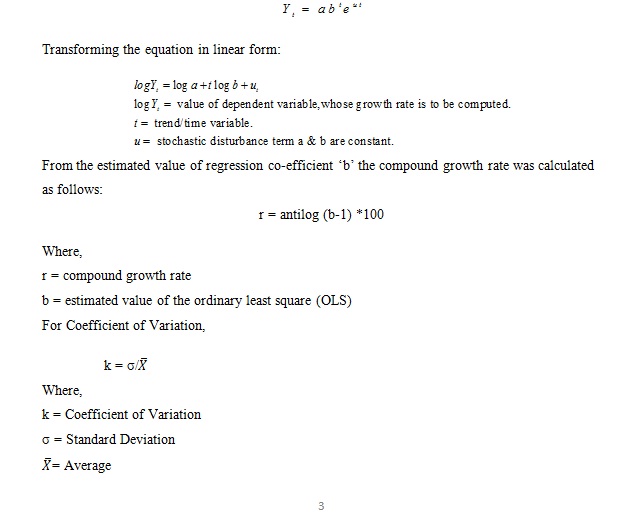
SOCIAL SECTOR SCENARIO IN PUNJAB
Social Sector Scenario in Punjab: Punjab has experienced many upheavals and chaos, which, in turn, have influenced its path of development. Punjab’s population has increased five times in the last 60 years and in which majority of population is under the age of thirty. The thrust of development programmes aim to reach the needy sects of our society which require the utmost attention. High priority is being accorded to education, health and nutrition and livelihood. The main concern, however, is to improve national and individual welfare through multiple pathways including more productivity, more earning, improving health, enriching lives through empowerment and gives the better opportunities i.e. creating greater equity through opportunity (Government of India, 2012). The expenditure on social and community sector has increased from 12.2 percent to 28.62 percent over the period of the Fourth Five Year Plan to Eleventh Five Year Plan.
|
Fourth Plan |
Fifth Plan |
Sixth Plan |
Seventh Plan |
Eighth Plan |
Ninth Plan |
Tenth Plan |
Eleventh Plan |
Twelfth Plan (P) |
|
|
Expenditure on Social and Community Services (In Percent) |
12.23 |
20.38 |
16.24 |
13.44 |
22.83 |
28.42 |
22.35 |
28.62 |
35.12 |
Source: Government of Punjab (Various Issues), “Statistical Abstracts of Punjab”, Chandigarh: Economic Advisor to Punjab.
Social Development Schemes launched by State Government:
SECTION III
SOCIAL SERVICES: OUTLAYS AND ACTUAL EXPENDITURE
Table 1 explains the overall outlays and actual expenditure incurred for Social sector development in Punjab from the year 2007-08 to the year 2015-16. The highest amount allotted to Education, Art & Culture followed by Social Security and Women & Child Care, then on Medical and Public Welfare and Welfare of Minority sections. While Water Supply and Sanitation and Labour welfare and employment get the least share out of total allocations. However, the highest expenditure incurred on Social security and Women & Child Care followed by Education, Art & Culture, Water Supply and Sanitation and Welfare of Minorities Sections. Bains (2016) stated that during these nine years Punjab Government had successfully implemented multi pronged strategy to consolidate its fiscal condition by raising revenue through collection of taxes and curbing debt in order to bring financial prudency in the system. The state’s own tax revenues had increased from Rs. 36808 crore to Rs. 1.68 lakh crore during this period. In addition to these, the Government had also taken numerous steps for provisioning of basic amenities to all, infrastructure, power generation and implementation of administrative reforms in civil, police and industrial sector. Punjab is the only state providing free power supply to farmers about Rs. 4700 crore every year in lieu of subsidy to Punjab State Power Corporation Limited (PSPCL). Despite increased allocation during the last decade, both State and Centre expenditure had not attained the decided growth. Little attention had been paid to the utilization of the allocated funds. The phenomenon of under utilization in the different sectors and scheme had been reflected in the budget allocations, releases and utilization of funds in the different sectors and schemes. The funds allocated for different programme components and sub components were underutilized and unnoticed because of the lack of an adequate financial management information system (Shariff, Ghosh and Mondal, 2002)
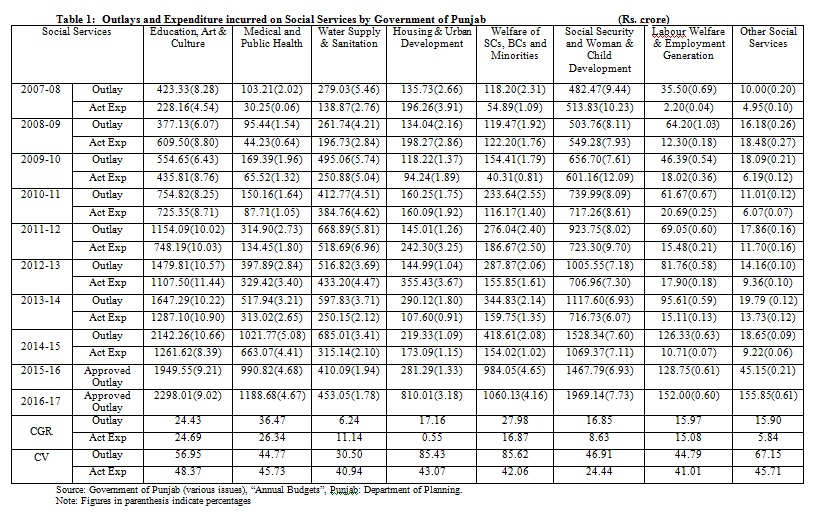
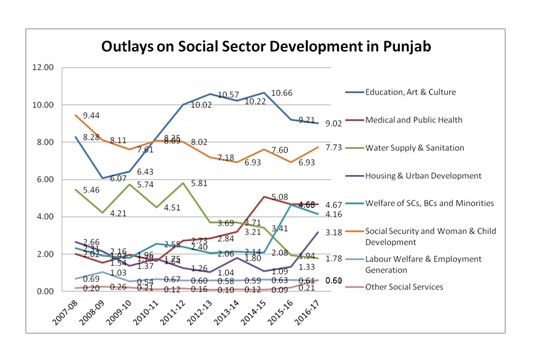
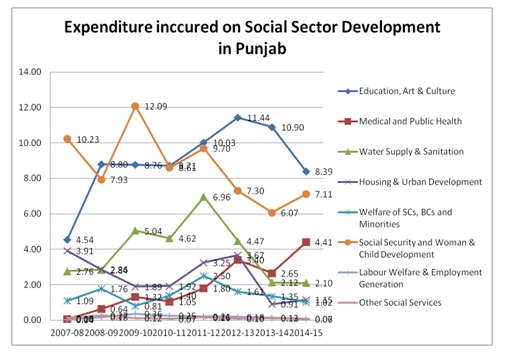
Table 2 explained that the Shiromani Akali Dal Government initiated various scholarship schemes which include schemes for students as well as for institutions. Schemes like Post metric scholarship scheme for Minorities sections, Rajiv Gandhi National Fellowship, Dr. HarGobind Scholarship scheme for merit holders, Financial Support to disabled person and dependent child were launched to provide support to vulnerable sections. The State Government disbursed Rs. 200 crore among 3.14 lakhs students during the period of 2007-2015. A positive contribution to the social good is made by the Government, which has helped in transforming Punjab from ignorance to knowledge. Besides sprucing up infrastructure in schools, empowering the girls is the biggest challenge for the Government.
Shagun scheme played the important role for helping the under privileged families during the time of girls marriage. Rs. 41.44 crore had been transferred within the accounts of 58362 beneficiaries in the year 2015. The number of beneficiaries had been showing the increasing trend for the schemes like Attendance scholarship to girls, Financial Assistance to Widows and Destitute Women and Financial support to dependent child and for disabled person. Women Development Department was established on April 4, 2012 under Punjab Women Empowerment Package 2012 (PWEP) to transform the socio economic status of women by expanding opportunities available to them (The Hindu, 2016).
Government had provided free water connections and toilets in rural areas. There had been expenditure of around Rs. 3000 crore to repair old roads and a total investment of about Rs. 32000 crore for building new roads (approximately 28000 kms.) in nine years. A lot of focus had been laid on preserving the Sikh Cultural Heritage. Upgrading health infrastructure, better delivery services and affordable treatment achieved success by reaching out to 28 lakh blue card holders during these nine years. Atta Dal Scheme was implemented by the Badal Government in 2007 which covered 15.4 lakh families providing each with Rs. 4 per kg wheat and Rs. 20 per kg dal by subsiding wheat to Re 1 per kg. The scheme entailing an annual expense of Rs. 400 crore had been flawed by complaints of erratic supply of pulses, undeserving beneficiaries and low quality wheat (Hindustan Times, 2016).
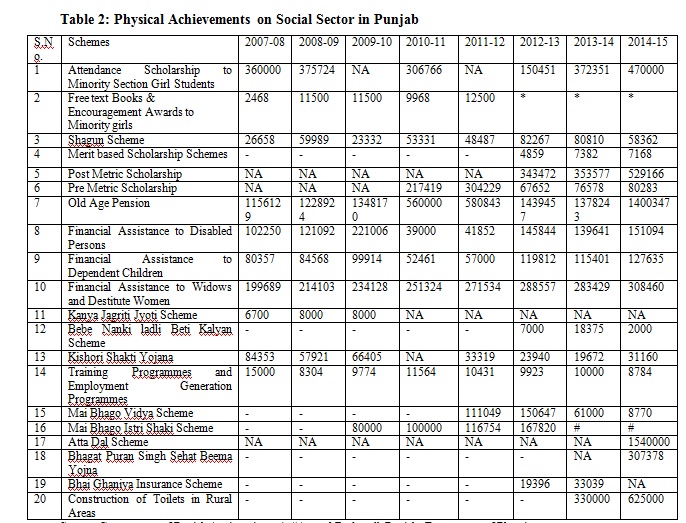
Source: Government of Punjab (various issues), “Annual Budgets”, Punjab: Department of Planning.
Note: * indicate that schemes shifted to non plan.
-indicate that schemes were not started.
# indicates that discontinuance of schemes.
NA means Not Available
There has been opening of 13 Universities and 30 colleges in this duration. 297 skill development centres, 750 free Health check up Centres and 1933 free Medical Centres have been opened. Advance Cancer Research and Treatment Centre, Bathinda has been opened. New Tube wells connection, Free Health Bema services, Concessional Loan and Free power supply provided to Farmers. Mai Bhago Vidya Scheme was introduced with an objective of ensuring there are no drop outs of girls in Punjab Schools. Rs. 42 crore spent on this scheme; proved to be successful as in first year, the total of 111049 bicycles were distributed rose in second year to 152330 bicycles (Anonymous, 2016). However, Punjab Government failed to this promise because the number was dropped to 61000 bicycles in the year 2014 and Director General School Education (DGSE) said that they had not received any instructions to distribute bicycles the girls so far and the number further dropped to 8770 in the year 2015 (India Today, 2015).
Under Sangat Darshan Programmes, The CM meets the people to redress their grievances. A proper format is followed to solve the problems of needy. The complaints are filed by the applicant online which further solved by the Government. During Sangat Darshan, Mr. Badal said that 164 Fard kendras, 132 Suvidha Kendras and 500 Saanjh Kendras were opened and alreasy providing services to the public. Besides this, 2174 Sewa Kendras were being set up costing Rs. 2000 crore for delivery of Government to Citizen (G2C) and Business to Citizen (B2C) services in rural as well as urban areas at a cost of Rs. 450 crore.
SECTION IV
POLICY IMPLICATIONS
In the light of above discussion, following policy implications can be given for the social sector development in India which definitely eliminate poverty.
CONCLUSION
An Economic and social change has to be adopted simultaneously as parallel parameters for promoting development of such an economy. A steady progress, thereby, ensures two wider objectives i.e. full employment and the removal of economic inequalities and rechanneling the economic activity at the same time. Economic growth though important cannot be an end in itself. Higher standards of living as well as of development opportunities for all, stemming from the greater resources generated by economic growth, are the ultimate aim of development policy. This implies the need to bridge regional, social and economic disparities, as well as the empowerment of the poor and marginalized, especially women, to make the entire development process more inclusive Punjab has always been on top list for offering a huge number of opportunities to ladies, children and to the weaker sections. Various schemes were launched had been successfully implemented and well achieved also to empower these sections within the state for uplifting their education, economic and social status. Most of the government policies are directed towards bringing weaker section to main stream primarily through trickle down approach but it is not only the formulation of programmes and policies, rather the crux lies in its proper implementation. The results clearly show that there is significant reduction in poverty due to social sector expenditure in Punjab. Therefore, the expenditure on these social services should continue in the planning process of Punjab. In order to remove poverty and for equal distribution of income among the masses, it is necessary for the government to provide more and more employment opportunities to the poor. Further, inclusive growth has been the main strategy of development, yet, exclusion continued in terms of low agriculture growth, low quality employment growth, low human development, rural-urban divides, gender and social inequalities, and regional disparities etc.